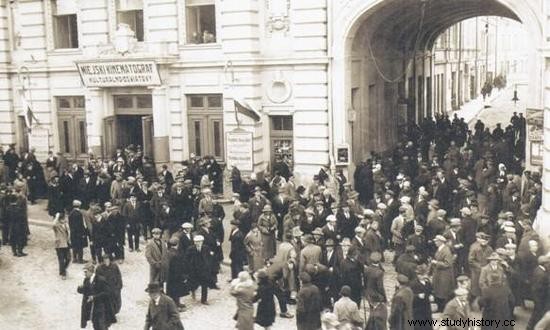Cosa nostra, Camorra, Yakuza. Our own Polish mafia should also be added to this list of known foreign criminal organizations. It was called Bruderferajn and it operates in pre-war Vilnius. In its heyday, it had over a thousand members, bringing together the entire local underworld!
The beginnings were quite innocent. Here it is during the tsar, because in January 1911, two friends - Saszka Lichtsohn aka Lichtstein and Aron Wójcik - were developing a plan for an organization that would constitute a kind of thieves' self-help. As Monika Piątkowska writes in the book "Criminal life in pre-war Poland" it was assumed that it would be an association that would provide support and care to local burglars. However, only three years have passed, and Bruderferajn has turned into a predatory, large organization whose primary source of income has been the extortion of ransoms and payments on merchants .
Bruderferajn - blackmail, kidnapping and bombs
The group did not mince measures to achieve its goal. Intimidation, beatings, kidnappings, and even bombing and murdering of those who refused to pay were commonplace. Even the outbreak of World War I did not harm the dynamically developing "enterprise".

Vilnius. Such a beautiful and peaceful city. Who would have expected that it was there that the largest criminal organization operated in interwar Poland?
Everything worked in the old way, as a certain merchant who wanted to leave Vilnius found out. The bandits demanded a trifle of three thousand zlotys from him on this occasion. Are you wondering if it's a lot? Definitely yes, because the three thousand gold rubles of that time were worth over two kilograms of gold. In the absence of "cooperation" the trader was threatened with death.
The latter, however, had no intention of paying and reported to the police. And it was a serious mistake on his part. The officers did not catch anyone, and the criminals retaliated by planting an explosive in the reluctant gentleman's apartment, which partially demolished the tenement house and seriously injured him and his son.
Golden times of Bruderferajn
However, the real flourishing of the organization was brought only by free Poland. After the fighting at the front ceased and peace with the Bolsheviks was signed in Riga, a golden age has come for the Bruderferajn leadership. Their organization grew to such an extent that all the criminals in the city were included, with about 1,000 members. It got to the point that in order to cover such a large number of people and interests, the mafiosi founded a professional law office, which was located in the apartment of the "president" Lichtsohn, also known as Chana Bobkes. As Monika Piątkowska writes:
Files of merchants and wealthier residents of Vilnius, accounting books, black books of offenses, misdemeanors and betrayals of individual members and a refractory fund with an administrative fund were kept in the "official" room .
Proportionally to the growth of the criminal group, the income of its bosses also increased, which, apart from tribute from merchants, collected a percentage of each "work" performed by members of the organization. They were a kind of membership fees.

As befits a real mafia, the payroll of Bruderferajn also includes police officers.
They guaranteed that in the event of a mishap, the detainee's family would receive a special allowance. Bruderferajn not only cared for her people in this way. Lawyers and policemen were paid and, if necessary, inconvenient witnesses were eliminated. At the same time, there was a mafia "court" that kept order in its ranks.
This article has more than one page. Please select another one below to continue reading.Attention! You are not on the first page of the article. If you want to read from the beginning click here.
Everything ends sometime
It was one of the sentences he had given that caused the fall of Bruderferajn. He once condemned the thief Elka Gurwicz to death, who did not want to submit to the organization, and what was worse even attacked the board members with a weapon in his hand . Gurwicz was shot in Vilnius, but he had friends who were very anxious to avenge his fallen comrade. However, they had enough headache not to challenge some people to the all-powerful mafia. Instead they used the police.

Photo of Josel Lejbowicz and one of the kidnappers, taken in front of the bandits' hideout. The kidnapping of the son of the owner of the Kresovia exchange was the last major action of Saszka Lichtsohn. Once the boss of Brudenferajn. The photo comes from Monika Piątkowska's book "Criminal life in pre-war Poland" (PWN, 2012).
They flooded the Vilnius officers with a wave of anonymity in which they explained in detail the structure of the organization, its composition, sources of income, crimes and plans, giving the officers evidence on such . In this situation, the law enforcement officers had an easy task.

On two occasions, most of the prominent members of Bruderferajn were caught. The rest, wanting to avoid imprisonment, scattered throughout the country. In a trial in 1924, Lichtsohn and Wójcik were sentenced to several years in prison.
Grenades in the ash pan
The history of the Vilnius mafia also has an epilogue. After their bosses were released in the early 1930s, they both tried to revive the organization. Now, however, old friends had real hatred for each other. Each of them had their own group and they tried to send each other to the afterlife, putting ... grenades in the ash pans in their furnaces .
The last time what was left of the once powerful Bruderferajn made itself felt in February 1932. It was then that Chana Bobkes and his men who signed the name "Golden Banner" kidnapped eight-year-old Josel Lejbowicz, the son of the owner of the "Kresowja" exchange office. Lejbowicz was considered the richest inhabitant of Vilnius, therefore the bandits demanded 14,000 zlotys (approximately 140,000 zlotys) for freeing the child.

After the destruction of Bruderferajn, the inhabitants of Vilnius could feel a bit safer.
This time the police did a great job and quickly tracked down the kidnappers, arresting most of them. Those who avoided the temporarily punishing hand of justice released the boy after three days. As Monika Piątkowska writes in her book: After a loud trial, reported by all the media in the country, Saszka Lichtsohn was sentenced to four years in prison, which ended the history of Bruderferajn, the largest thieves' organization in the interwar period .
